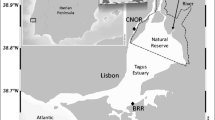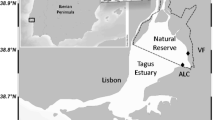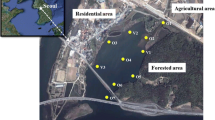Abstract
Sediment core samples were collected from the Weihe River in February and August 2013. Cores were sectioned and analyzed for total Hg (THg) and methyl mercury (MeHg). THg in sediment cores ranged from 156 to 282 ng g−1 in February, and from 172 to 300 ng g−1 in August. MeHg concentrations ranged from 0.80 to 3.11 ng g−1 in both seasons. Results showed that the diffusive fluxes were up to two orders of magnitude lower than the in situ benthic fluxes. Fluxes of MeHg measured in in situ experiments in August were positively correlated with \( {\text{SO}}_{4}^{2 - } \) (r = 0.930). THg and MeHg release were not strongly correlated with TOC in February. Patterns of MeHg flux differed greatly depending on oxidation–reduction potential (Eh) (r > 0.70) conditions in the two seasons.
Similar content being viewed by others
Explore related subjects
Discover the latest articles, news and stories from top researchers in related subjects.Avoid common mistakes on your manuscript.
For many years, mercury (Hg) has received much attention globally because of its high toxicity, bioaccumulation potential, and persistence in different environments. Organic Hg, primarily methyl mercury (MeHg), is the form that bioaccumulates through the foodweb, and so poses the greatest threat to human health (Fitzgerald et al. 2007). To improve our understanding of the relationships between sources of mercury and bioaccumulation of MeHg in the foodweb, it is necessary to integrate our current understanding of the processes governing the transport and fate of mercury in the environment (Ethier et al. 2012).
The relationships between watershed characteristics and the concentration, speciation, and mobility of mercury in rivers needs further study so that we can provide improved descriptions of mercury cycling dynamics within watersheds, or freshwater ecosystems (Brigham et al. 2009; Barringer et al. 2010). Sediment profiles can help us determine inventories and accumulation rates of mercury in water bodies. However, because of the formation and degradation of MeHg in sediments, it is difficult to study mercury dynamics using solid phase profiles alone. Additional data about MeHg and THg (total mercury) fluxes between sediment and water are needed to determine the transport and fate of MeHg. Multiple approaches have been used to examine the exchange of Hg and MeHg at the sediment/water interface. These include diffusion estimates based on pore–fluid concentration gradients (Hammerschmidt and Fitzgerald 2006), a diffusive gel time-series study of mercury mobilization in estuarine environments (Merritt and Amirbahman 2007), and the quantitative water–air–sediment interaction (QWASI) model to quantify the fluxes of mercury at the water/air and sediment/water interfaces of an urban river (Tong et al. 2014). Of these, in situ benthic flux chambers arguably provide the most environmentally realistic measurement of exchange at the sediment/water interface.
The Weihe River drains an area of 12,921 km2 in Henan Province, China, and is the largest tributary of the Haihe River, North China. Land use in the Weihe Basin is mainly agricultural. The annual average precipitation in the Weihe River Basin is about 500 mm, and rainfall is concentrated into a very short period during the summer. Direct atmospheric deposition, surface and groundwater flow, and localized anthropogenic sources such as power generation, mining, incineration, paper mills, and water treatment facilities are thought to be the main inputs of new mercury into the Weihe River. The main aim of this study was to investigate the mobility of Hg species (THg and MeHg) at the sediment/water interface in the Weihe River, based on both the estimation of diffusive fluxes and in situ measurements of benthic fluxes using benthic chambers.
Materials and Methods
Sediment core samples were collected in triplicate using a piston corer at a depth of 2 m from one sampling location (35°18′26″N, 113°53′36″E) in the Weihe River on February 20 and August 10, 2013. The corer was equipped with a 5-cm-diameter polycarbonate core barrel, and was operated from the surface by lightweight magnesium extension drill rods. The cores were extruded and sectioned within a few hours of collection; the first 10 cm was sectioned at 1-cm intervals, while the next 20 cm was sectioned at 2-cm intervals. Although the core was processed in the open atmosphere, care was taken to minimize the exposure time so that MeHg concentrations in sediment and pore water would not be affected by oxidation. Each core section was placed in a 100-mL polypropylene jar. Samples were transported on ice to the laboratory, frozen, and then freeze-dried for analysis.
Benthic fluxes chambers (BFCs) were developed and used to measure the in situ efflux of Hg from sediments in Weihe River, which consists of three main parts: (1) the “flux chamber,” a coring tube that contains undisturbed sediment and overlying water, (2) the “stirring head,” a polyethylene tube cap with Teflon-coated magnetic stir bar, and (3) a direct current motor with button magnet. The coring tube (6.0 cm i.d., 7.0 cm o.d., 30 cm length) is made of polyethylene with a bevel on one end for easier sediment penetration. The stirring head (10 cm diameter, 3.5 cm height) is positioned atop the flux chamber when in use. It is machined from solid polyethylene and has a lower and upper well. The lower well (7 cm diameter, 1 cm deep) fits snugly over the outside of the chamber tube, and it has a Teflon coated, floating magnetic stir bar (5.4 cm diameter) that is attached to the upper center of the lower well. The upper well houses a button magnet that is attached to a direct current motor, which rotates the stir bar inductively (Tengberg et al. 1995; Hammerschmidt and Fitzgerald 2006; Koron and Faganeli 2012). Benthic fluxes of mercury were assessed on the same dates that the cores were collected (February 20 and August 10, 2013). An in situ BFCs was deployed on the river floor, thereby isolating an area of sediment surface and overlying water. A plastic skirt, fitted to the outside of the chamber, controlled its penetration into the sediment to a depth of about 10.0 cm. Sample collection from the chamber was via two stopcocks on the lid, and the volume of water removed during sampling was compensated by river water. Samples were collected through a flexible polyethylene tube, at 2 h time intervals over a whole day. Water samples collected from the chamber were analysed for dissolved oxygen (DO), \( {\text{SO}}_{4}^{2 - } \), Eh, THg and MeHg.
Results and Discussion
Profiles of THg and MeHg in the sediment cores are shown in Fig. 1a. Results show that the THg concentrations in sediment were significantly different between the two seasons. For example, concentrations of THg in sediment cores ranged from 156 to 282 ng g−1 in February and from 172 to 300 ng g−1 in August. The distribution profiles show that the THg concentrations decreased from the top to the bottom of the sediment cores, and that the THg concentrations were highest in the top 10 cm for both seasons. These higher THg concentrations in the upper part of the sediment profiles may indicate increased Hg discharges from anthropogenic sources surrounding the Weihe River in recent decades due to local industrial and agricultural development. Compared with sediment quality guidelines (Long et al.1995), Sediments from Weihe-river were most toxic due to exceeding Lowest effect leve (ERL = 150 ng g−1) values for THg. THg concentrations in this study were far lower than those found in some Hg-polluted rivers in Canada (284–5100 ng g−1) (Canário et al. 2008) but was higher than those in background lakes, such as lake sediment core from Ny Alesund in Svalbard (21–48 ng g−1) (Jiang et al. 2011). MeHg concentrations in the sediment ranged from 0.80 to 3.11 ng g−1 in both seasons. MeHg concentrations decreased from the top to the bottom of the sediment cores collected in February; while in the cores collected in August, the peak MeHg concentration occurred at 8–10 cm deep (Fig. 1a). The maximum MeHg concentrations in the sediment cores were higher in August than in February. The ratio of MeHg/THg varied from 0.39 to 0.77 % with an average of 0.64 % in February and from 0.48 to 1.12 % with an average of 0.87 % in August. This is may be caused by the higher temperatures in August because higher temperatures can stimulate the metabolism of biofilm and enhance the methylation process of inorganic Hg in sediment.
THg and MeHg profiles in porewater were shown in Fig. 1b. It should be noted that THg profiles in porewaters was not proportional to the sediment profiles in August.
This result suggests that Hg concentration in porewaters is not controlled by an exchange equilibrium between the two phases. The concentration profile of THg and MeHg in porewaters collected in August exhibits the greatest variability and the most peculiar trend. The increase of MeHg content was clearly localized at a depth between 5 and 15 cm in porewater profile from August, where the highest concentration was detected (8.8 ng L−1). The MeHg concentration profile in February showed a similar increasing trend with depth as that mentioned for THg in sediment. This would indicate that the recent sediment (0–10 cm) could be a source of MeHg for the water column of the study areas.
Diffusional effluxes, estimated from the vertical concentration gradients of MeHg, are presented in Table 1, and are compared with fluxes determined with the BFCs. Benthic MeHg fluxes measured with the BFCs are comparable to the diffusional estimates for August. The relatively good agreement between measured and estimated diffusional fluxes suggests that molecular diffusion may be the primary process influencing the exchange of MeHg at the sediment/water interface in August. In contrast, benthic fluxes of MeHg measured with BFCs were 2.3 fold larger than the diffusional estimates in February, implying that diffusion was not the only transport process that influenced sediment/water exchange of MeHg in winter (Wang et al. 2012). It is also interesting to note that, even though the Hg content in the sediment from August was lower than in February, MeHg fluxes were higher than those observed in February. This suggests that Hg and MeHg mobilization is more active in August than in February, and temporal differences in the fluxes may be due to (1) the biofilm cover on the sediment that resulted in increased MeHg production in summer, and/or (2) the influence of temperature on rates of molecular diffusion (Rothenberg et al. 2008).
Table 2 showed Pearson correlation coefficients of THg, MeHg, chemical and physical parameters during in situ daily flux chamber experiment. Results suggest that the THg content does not seem to be a good predictor of the Hg methylation potential, so other factors, such as the Hg speciation of the solid phase, the quality of TOC, and the sulfide contents, should be considered. Although organic carbon was correlated with Hg and MeHg fluxes, it appears that their release was not so strongly linked to TOC in the February chamber experiment (r = −0.211; r = − 0.058, n = 12). TOC− and THg were significantly and positively correlated (r = 0.999) in the August chamber experiment, which suggests that TOC played an important role in the THg flux in August. Conversely, there was a significant negative correlation between MeHg and TOC (r = − 0.585), which indicates that all species of mercury promoted the formation of TOC-Hg in August, thereby decreasing the production of methyl mercury (MeHg). Patterns of MeHg flux differed greatly depending on Eh (r > 0.70) conditions in the two seasons; concentrations were lower under low Eh than high Eh conditions, and were higher under aerobic conditions. \( {\text{SO}}_{4}^{2 - } \) and MeHg fluxes were positively correlated in in situ experiments in August (r = 0.930; see Table 2b). Meanwhile, MeHg concentrations and \( {\text{SO}}_{4}^{2 - } \) were significantly and positively correlated in the sediment core from August (r = 0.90; p < 0.05).The sediment was covered in biofilm in August, which may have stimulated the metabolism of \( {\text{SO}}_{4}^{2 - } \) reducing bacteria (SRB), and enhanced the inorganic Hg methylation process in sediment (Chios and Bartha 1994). Microbial activity is the main factor that controls MeHg concentrations in sediments, because of the relative concurrent rates of methylation and demethylation processes.
In conclusion, this paper provides important information on sediment–water fluxes of total Hg and MeHg at the sediment/water interface. The highest profile concentrations of THg in both seasons were observed in the top 10 cm. MeHg concentrations decreased from the top to the bottom of the sediment profiles from February, while the peak MeHg concentrations occurred at depths of 8–10 cm in the August sediment profiles. Sediment/water fluxes of MeHg were greater in summer than in winter. Mean measured fluxes were about three times greater in August than in February. In situ investigations showed that total Hg and MeHg flux patterns differed greatly depending on the Eh in the two seasons; concentrations were lower when Eh was low, and were higher in aerobic conditions.
References
Barringer JL, Riskin ML, Szabo Z, Reilly PA, Rosman R, Bonin JL, Fischer JM, Heckathorn HA (2010) Mercury and methylmercury dynamics in a Coastal Plain watershed, New Jersey, USA. Water Air Soil Pollut 212:251–273
Brigham ME, Wentz DA, Aiken GR, Krabbenhoft DP (2009) Mercury cycling in stream ecosystems. 1. Water column chemistry and transport. Environ Sci Technol 43:2720–2725
Canário J, Poissant L, O`Driscoll NJ, Ridal J, Delongchamp T, Pilote M, Constant P, Blais J (2008) Mercury partitioning in surface sediments of the upper St. Lawrence River (Canada): evidence of the importance of the sulphur chemistry. Water Air Soil Pollut 187(1–4):219–231
Chios SC, Bartha R (1994) Environmental factors affecting mercury methylation in estuarine sediment. Bull Environ Contam Toxicol 53:805–812
Ethier ALM, Atkinson JF, DePinto JV, Lean DRS (2012) Estimating mercury concentrations and fluxes in the water column and sediment of Lake Ontario with HERMES model. Environ Pollut 161:335–342
Fitzgerald WF, Lamborg CH, Hammerschmidt CR (2007) Marine biogeochemical cycling of mercury. Chem Rev 170:641–662
Hammerschmidt CR, Fitzgerald WF (2006) Methylmercury cycling in sediments on the continental shelf of southern New England. Geochim Cosmochim Acta 70:918–930
Jiang S, Liu XD, Chen QQ (2011) Distribution of total mercury and methylmercury in lake sediments in Arctic Ny-Alesund. Chemosphere 83:1108–1116
Koron N, Faganeli J (2012) Benthic fluxes of mercury during redox changes in pristine coastal marine sediments from the Gulf of Trieste (northern Adriatic Sea). J Soils Sediments 12:1604–1614
Long ER, MacDonald DD, Smith S, Calder F (1995) Incidence of adverse biological effects within ranges of chemical concentrations in marine and estuarine sediments. Environ Manag 19:81–97
Merritt KA, Amirbahman A (2007) Mercury mobilization in estuarine sediment porewaters: a diffusive gel time-series study. Environ Sci Technol 41:717–722
Rothenberg SE, Ambrose RF, Jay JA (2008) Mercury cycling in surface water, porewater and sediments of Mugu Lagoon, CA, USA. Environ Pollut 154:32–45
Tengberg A, De Bovee F, Hall P, Berelson W, Chadwick D, Ciceri G, Crassous P (1995) Benthic chamber and profling landers in oceanography—a review of design, technical solutions and functioning. Prog Oceanogr 35:253–294
Tong YD, Zhang W, Chen C, Chen L, Wang WT, Hu XD, Wang HH, Wang XJ (2014) Fate modeling of mercury species and fluxes estimation in an urban. Environ Pollut 184:54–61
Wang SF, Xing DH, Jia YF, Biao Li, Wang KL (2012) The distribution of total mercury and methyl mercury in a shallow hypereutrophic lake (Lake Taihu) in two seasons. Appl Geochem 27:343–351
Acknowledgments
This study is supported by National Nature Science Foundation of China (Project No. 41101473). Key scientific and technological projects of Henan Province (112102310442).
Author information
Authors and Affiliations
Corresponding author
Rights and permissions
About this article
Cite this article
Li, Q., Jiang, L., Wang, D. et al. Sediment Profile and Fluxes of Mercury and Methyl Mercury in Weihe Watershed in Henan, China. Bull Environ Contam Toxicol 95, 51–55 (2015). https://doi.org/10.1007/s00128-015-1549-x
Received:
Accepted:
Published:
Issue Date:
DOI: https://doi.org/10.1007/s00128-015-1549-x





